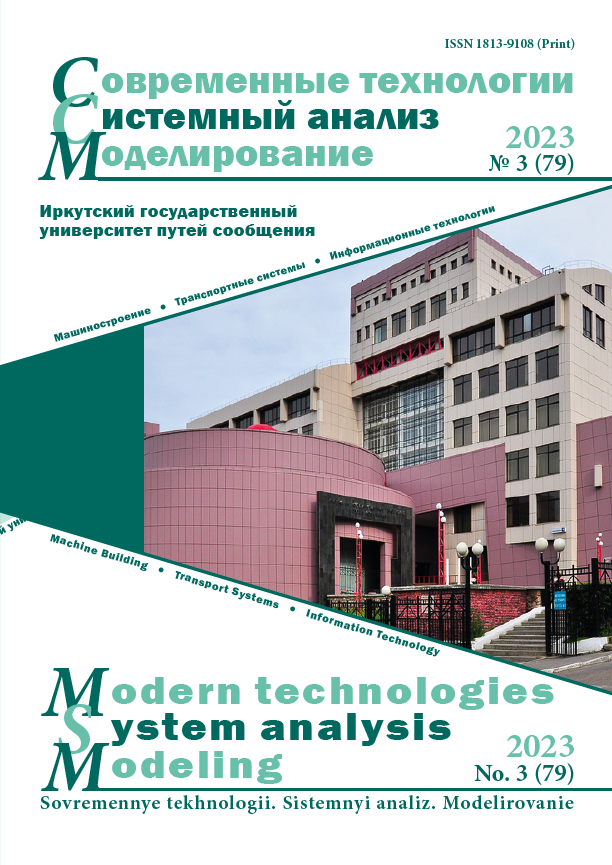Determining the level of residual stresses by computer simulation in turning heat-resistant materials
Keywords:
residual stresses, cutting conditions, computer model, heat-resistant materials, deformation, destructionAbstract
One of the factors of the quality of the machined surface is the residual stresses arising after machining, which are important for the durability and reliability of structures and products. In this regard, the relevance of determining residual stresses, especially after machining, is becoming an increasingly important task. Residual stresses must be taken into account when designing and manufacturing products. Measuring residual stresses allows to determine their level and distribution in the material, which helps prevent problems and damage during operation, it also allows to optimize processing processes and improve the quality and reliability of products. There are various methods for measuring and relieving residual stresses, such as mechanical, X-ray diffraction, acoustic and others. They all have their advantages and disadvantages, and the choice of method depends on the specific requirements and conditions. However, there is no way to predict the required level of residual stresses at the stage of technological design of a product. This article proposes and describes a technique based on the use of computer modeling, which allows to predict and control the level and magnitude of residual stresses even at the stage of technological preparation for production. The use of computer simulation in conjunction with material and processing data makes it possible to fine-tune processing parameters to achieve the desired level and sign of residual stresses, which will increase production efficiency and reduce the likelihood of product defects.
References
Безъязычный В.Ф. Влияние технологических условий механической обработки на величину и характер распределения остаточных напряжений в поверхностном слое детали // Вестник РГАТУ им. П.А. Соловьева. 2020. №1 (52). С. 51–57.
McClung R.C. A literature survey on the stability and significance of residual stresses during fatigue // Fatigue & Fracture of En-gineering Materials & Structures. 2007. Vol. 30, Iss. 3. P. 173–205.
Биргер И.А. Остаточные напряжения. М. : Машгиз, 1963. 232 c.
Макаров А.Д. Оптимизация процессов резания. М. : Машиностроение, 1976. 278 с.
Мухин В.С. Поверхность. Технологические аспекты прочности деталей ГТД. М. : Наука, 2005. 295 с.
Процессы формообразования деталей в машиностроении / В.М. Кишуров, Н.К. Криони, В.В. Постнов и др. М. : Маши-ностроение, 2015. 496 с.
Буркин С.П., Шимов Г.В., Андрюкова Е.А. Остаточные напряжения в металлопродукции. Екатеринбург : УрФУ, 2015. 247 c.
Fe Modelling and Simulation of the Turning Process Considering the Cutting Induced Hardening of Workpiece Materials / J. Li, F. Jiang, A. Jin et al. // SSRN : site. 2023. Jul. DOI: 10.2139/ssrn.4511598.
Масленков С.Б. Жаропрочные стали и сплавы. М. : Металлургия, 1983. 191 с.
Меркулова Г.А. Металловедение и термическая обработка цветных сплавов. Красноярск : СФУ, 2008. 312 с.
Волков Г.М., Зуев В.М. Материаловедение. М. : Академия, 2008. 400 с.
Каталог Sandvik токарные инструменты 2017 // SteelCam : сайт. URL : https://docs.steelcam.org/sandvik/katalog-tokarnye-instrumenty-2017-page1 (Дата обращения 18.09.2023).
Резание материалов. Режущий инструмент / В.М. Кишуров, Н.К. Криони, В.В. Постнов и др. М. : Машиностроение, 2009. 491 с.
Обработка резанием в машиностроении / В.М. Балашов, В.В. Мешков, С.П. Рыков и др. Тверь : ТвГТУ, 2004. 176 с.
Резание материалов / С.Н. Григорьев, А.Г. Схиртладзе, В.А. Скрябин и др. Пенза : ПГУ, 2010. 628 с.
Технология машиностроения (в 2 кн.). Книга 1. Основы технологии машиностроения / Э.Л. Жуков, И.И. Козарь, С.Л. Мурашкин и др. М. : Высш. шк., 2003. 278 с.
Шифрин А.Ш., Резницкий Л.М. Обработка резанием коррозионностойких, жаропрочных и титановых сталей и сплавов. М. ; Л. : Машиностроение, 1964. 447 с.
Determination of the Johnson-Cook Constitutive Model Parameters of Materials by Cluster Global Optimization Algorithm / Z. Huang, L. Gao, Y. Wang et al. // Journal of Materials Engineering and Performance. 2016. Vol. 25. Iss. 9. P. 4099–4107. DOI: 10.1007/s11665-016-2178-1.
Соболев А.В., Радченок М.В. Использование модели пластичности Джонсона-Кука в численном моделировании брос-ковых испытаний контейнеров для транспортирования ОЯТ // Изв. высш. учеб. заведений. Ядерная энергетика. 2016. № 3. С. 82–93.
Deform-3D // Тесис : сайт. URL : https://tesis.com.ru/cae_brands/deform/3d.php (Дата обращения 18.09.2023).
A Gear Cutting Predictive Model Using the Finite Element Method / W. Liu, D. Ren, S. Usui et al. // 14th CIRP Conference on Modeling of Machining Operations. 2013. Vol. 8. P. 51–56. DOI: 10.1016/j.procir.2013.06.064
Precision radial turning of AISI D2 steel / J. Paulo Davim, C. Maranhao, P. Faria et al. // International Journal of Advanced Manufacturing Technology. 2009. Vol. 42. Iss. 9. P. 842–849. DOI:10.1007/s00170-008-1644-9.
Investigating Resulting Residual Stresses during Mechanical Forming Process / Stephen A Akinlabi, O.S. Fatoba, P.M. Mashinini et al. // 3rd International Conference on Mechanical, Manufacturing and Process Plant Engineering. Batu Ferringhi, 2017. Vol. 328. DOI: 10.1088/1757-899X/328/1/012012.
Овсеенко Е.С. Обеспечение качества изготовления маложестких деталей типа дисков газотурбинных установок за счет снижения технологических остаточных деформаций : дис. … канд. техн. наук. М., 2011. 144 с.
Криворучко Д.В., Залога В.А. Моделирование процессов резания методом конечных элементов: методологические ос-новы. Сумы : Университетская книга, 2012. 496 с.
Su Y. Effect of the cutting speed on the cutting mechanism in machining CFRP // Composite Structures. 2019. Vol. 220. P. 662–676.
Кильметова Л.Р., Хадиуллин С.Х., Черников П.П. Анализ исследований влияния элементов режимов резания на воз-никновение остаточных напряжений при механообработке // Металлообработка. 2019. №3 (111). С. 10–15.


